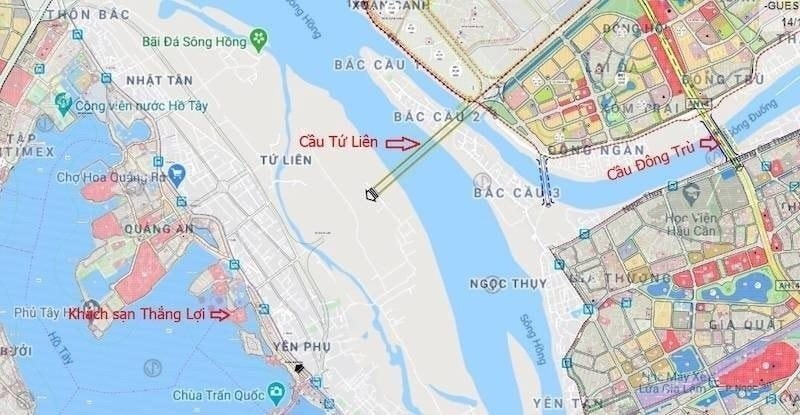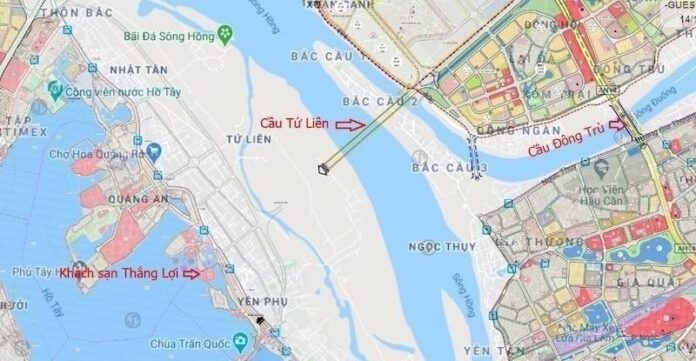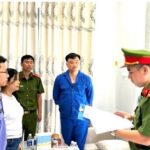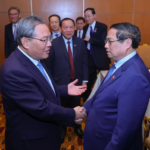The Tu Lien Bridge construction project and the approach roads (from the intersection with Nghi Tam Street to the intersection with Truong Sa Street) with a total investment of nearly VND 20,000 billion was inaugurated on the morning of May 19.
This mega-bridge project across the Red River comprises four sub-projects, with a total investment of approximately VND 19,830 billion. Of this, VND 4,332 billion is allocated for three sub-projects related to site clearance and resettlement.
The site clearance and resettlement sub-projects are located in three districts of Hanoi: Tay Ho, Long Bien, and Dong Anh, spanning across seven wards: Quang An, Yen Phu, Tu Lien, Ngoc Thuy, Xuan Canh, Dong Hoi, and part of Long Doi pagoda.
The total area for site clearance is approximately 62.53 hectares, affecting around 701 households (412 residential cases and 280 agricultural land cases, along with land belonging to organizations and public use). Approximately 257 households are expected to be resettled, including the Long Doi pagoda.

The Tu Lien Bridge and its approach roads are managed by the Project Management Unit for Transport Construction Works of Hanoi, with a total investment of about VND 15,498 billion. The construction contractor is a joint venture between Pacific Construction Group (China), VinGroup, and other partners.
The approach roads on the Nghi Tam side are 48 meters wide, while those on the Dong Anh side are 60 meters wide. The main Tu Lien Bridge is a cable-stayed bridge with a width of 43 meters, featuring a steel truss for the main span of 500 meters and a tower height of 185 meters. It also includes cast-in-place concrete bridges, steel bridges, two intersections with Nghi Tam and Truong Sa Streets, tunnels, technical infrastructure, sidewalks, architectural lighting, and greenery.
The Tu Lien Bridge is one of the 18 road bridges across the Red River in the Hanoi Transport Development Planning until 2030, with a vision towards 2050. Its goal is to connect transportation and socio-economic infrastructure on both sides of the Red River, contributing to the target growth rate of over 8% by 2025 and laying the foundation for double-digit growth in the following years for Hanoi and the country as a whole.
This is the first bridge project across the Red River inaugurated in 2025, paving the way for the commencement of six other significant bridge projects: Tran Hung Dao Bridge, Thuong Cat Bridge, Ngoc Hoi Bridge (Ring Road 3.5), Hong Ha Bridge, Me So Bridge (Ring Road 4), and Van Phuc Bridge.
The completion of the Tu Lien Bridge will facilitate connectivity between the Hanoi city center and the northern and northeastern regions across the Red River, as well as Thai Nguyen province. It will also provide a direct link to the National Convention Center and the road from Gia Binh Airport to Hanoi city center, contributing to the socio-economic development of Hanoi and the Capital Region.
With its unique design featuring a two-plane cable-stayed structure, a large main span length, and tower height, along with crossed cables on one plane, the Tu Lien Bridge will become a landmark in Hanoi’s architectural landscape. Upon its completion in 2027, it is expected to be one of the most iconic bridges in the city.
Indictment and Arrest of the Chairman of the People’s Committee and Four Subordinate Officials
Corruption within the ranks: Officials have been taking bribes to turn a blind eye to illegal construction on agricultural land.
“Vinhomes and Khai Hoan Land Elevate Their Strategic Partnership”
On May 27, 2025, Khai Hoan Land (HOSE: KHG) solidified its strategic partnership with leading developer Vinhomes (HOSE: VHM) by signing an agreement to distribute the Vinhomes Green City project. This marks a significant milestone in the long-standing collaboration between the two esteemed companies.
“Prime Minister Pham Minh Chinh Proposes China Prioritize Railway Cooperation”
During his meeting with Chinese Premier Li Qiang, Prime Minister Pham Minh Chinh proposed prioritizing railway cooperation and expressed his determination to commence the construction of the Lao Cai-Hanoi-Hai Phong route in 2025. He requested China’s support in preferential credit, technology transfer, and human resources development.
“Vietnam: Forging a Hungary-Southeast Asia Alliance”
During his meeting with Hungarian President Sulyok Tamás, General Secretary To Lam emphasized Vietnam’s commitment to its special relationship with Hungary. He affirmed Vietnam’s willingness to act as a bridge between Central European countries and Southeast Asia, while also exploring new avenues of cooperation in areas such as nuclear energy, defense, and innovation.
Japanese Businesses Should Invest in Vietnam’s Semiconductor Industry Now
With the ambition to become the semiconductor hub of the region and a crucial link in the global semiconductor supply chain, Vietnam has been attracting a significant number of foreign investors. Given the strong political and economic ties between our countries, Deputy Prime Minister Nguyen Chi Dung encourages Japanese businesses, particularly Kioxia Corporation, to seize the opportunity and invest in Vietnam’s semiconductor industry.





















